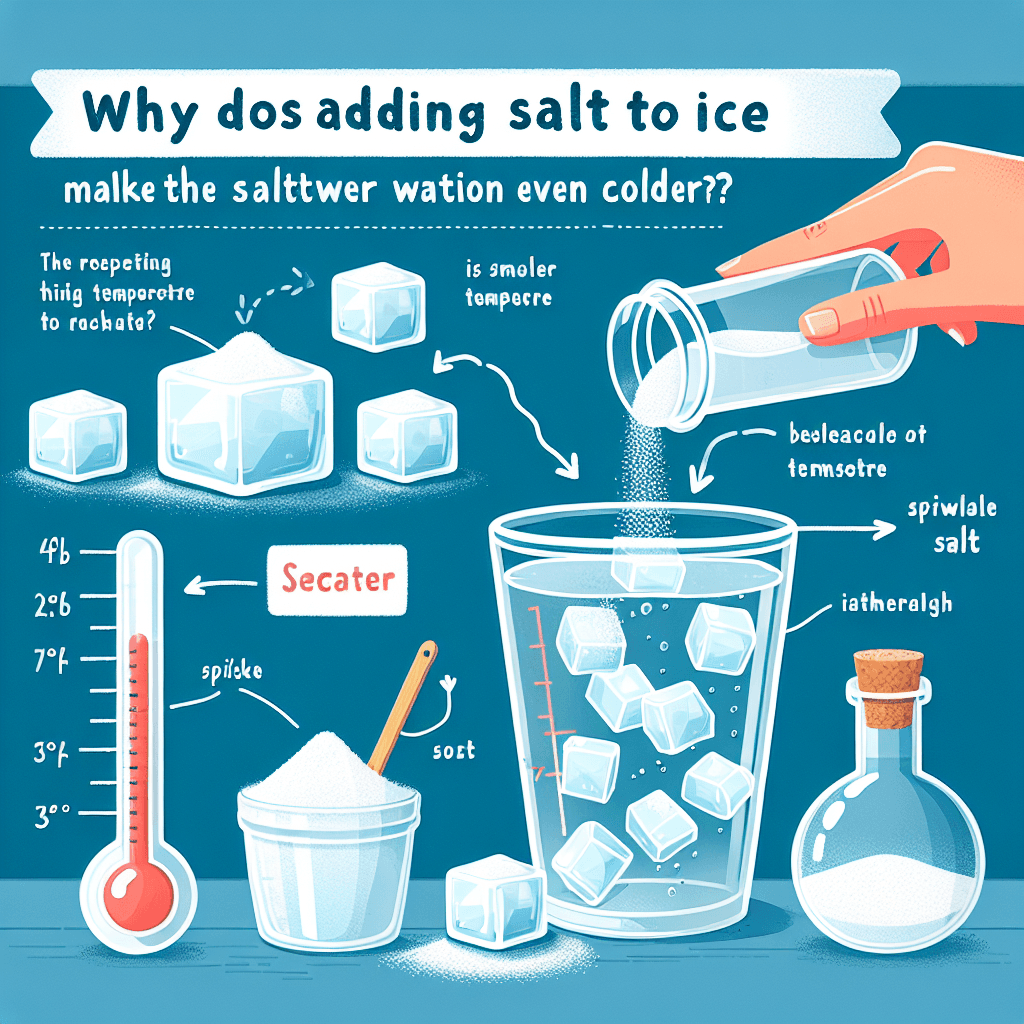Why does adding salt to ice make the resulting saltwater mixture even colder
It defies logic: adding simple salt to ice actually makes the mixture drastically colder than the ice was on its own. Discover the fascinating chemical reaction that forces the temperature to plummet far below freezing.


Too Long; Didn't Read
Salt lowers the freezing point of water, forcing the ice to melt. This melting process requires energy and absorbs heat from its surroundings, which makes the overall temperature of the saltwater mixture drop.
The Chilling Truth: Why Does Adding Salt to Ice Make the Resulting Saltwater Mixture Even Colder?
Have you ever made homemade ice cream in an old-fashioned crank machine? If so, you’ve participated in a fascinating science experiment. The recipe calls for packing a slurry of ice and rock salt around the inner canister. You might assume the salt simply helps melt the ice, but it does something much more surprising: it makes the ice-water mixture drastically colder than frozen water alone. This isn't kitchen magic; it's a fundamental principle of chemistry at play. Understanding this phenomenon reveals how simple ingredients can manipulate temperature in powerful ways. This post will break down the science behind why adding salt to ice creates a super-chilled solution.
The Dance of Freezing and Melting
Before we introduce salt, let's look at pure ice and water. The freezing point of water is 0°C (32°F). At this exact temperature, a dynamic equilibrium exists. Water molecules are constantly moving:
- Some liquid water molecules slow down enough to lock into the crystalline structure of the ice (freezing).
- Some ice molecules gain enough energy to break free from the crystal and enter the liquid state (melting).
At 0°C, these two processes happen at the exact same rate, so the overall amount of ice and water stays constant. Even on a solid block of ice, there is always a microscopic, thin layer of liquid water on its surface where this exchange is happening.
Enter Salt: The Science of Freezing Point Depression
When you sprinkle salt (sodium chloride, or NaCl) onto ice, it dissolves in that thin layer of surface water. This is where the chemistry begins to change. The salt splits into its component ions: positively charged sodium ions (Na+) and negatively charged chloride ions (Cl-).
These free-floating ions act as impurities in the water. They get in the way of the water molecules, disrupting their ability to organize and lock back into the rigid ice crystal structure. Think of it like trying to build a perfect wall of bricks (water molecules) while someone keeps tossing balls (salt ions) into your workspace.
The result is a process called freezing point depression. The rate of melting remains the same, but the rate of freezing is significantly reduced. Because melting is now "winning" over freezing, more ice begins to turn into liquid. For the equilibrium to be re-established—for freezing to catch up with melting again—the temperature of the mixture must get much, much lower. The freezing point of a typical saltwater solution can drop to as low as -21°C (-6°F).
The Energy Drain: Where the Cold Comes From
So, we've established that salt forces more ice to melt by lowering its freezing point. But why does this make the mixture colder? The answer lies in the energy required for a phase change.
Melting is an endothermic process. This means that for ice to transition from a solid to a liquid, it must absorb energy from its surroundings. This energy, known as latent heat of fusion, is used to break the strong hydrogen bonds that hold the water molecules together in the ice crystal.
When salt is added, it triggers a rapid, large-scale melting of the ice. To melt, every gram of that ice must pull heat energy from its immediate environment. The primary source of this energy is the surrounding saltwater itself. This sudden, massive withdrawal of heat energy causes the overall temperature of the ice-salt-water slurry to plummet dramatically, far below the standard 0°C (32°F) freezing point of pure water.
Real-World Applications
This powerful principle isn't just a neat party trick; it has practical uses all around us:
- Making Ice Cream: In an ice cream maker, the super-cold saltwater brine surrounds the inner chamber. It effectively pulls heat out of the cream mixture inside, allowing it to freeze solid without the brine itself freezing.
- De-icing Roads: Spreading salt on icy roads and sidewalks uses the same principle. The salt lowers the freezing point of the ice, causing it to melt into a liquid brine even when the air temperature is below freezing, making travel safer.
Conclusion
The reason adding salt to ice makes it colder is a two-part process. First, the salt disrupts the natural freezing-melting equilibrium, a phenomenon called freezing point depression, which forces more ice to melt. Second, this rapid melting is an endothermic process that requires a great deal of energy. The ice pulls this energy as heat from its surroundings, causing the temperature of the entire mixture to drop significantly. This simple interaction of salt and ice is a perfect example of how fundamental chemical principles govern everyday occurrences, from the roads we drive on to the desserts we enjoy.
More Articles

Why do movie punches sound so much crunchier and louder than real ones?
That sickening, bone-crunching punch you hear in the movies is a lie, and the secret ingredient is probably sitting in your refrigerator right now.

What makes a beer bottle suddenly foam over just from a light tap on top?
It’s not magic, it’s a shockwave; discover the explosive physics that turns a gentle tap on your beer bottle into an instant foamy geyser.

Why do police officers touch the back of a car during a traffic stop?
It’s not a random habit; that simple touch is a calculated, old-school tactic designed to leave a crucial and potentially life-saving piece of evidence behind.